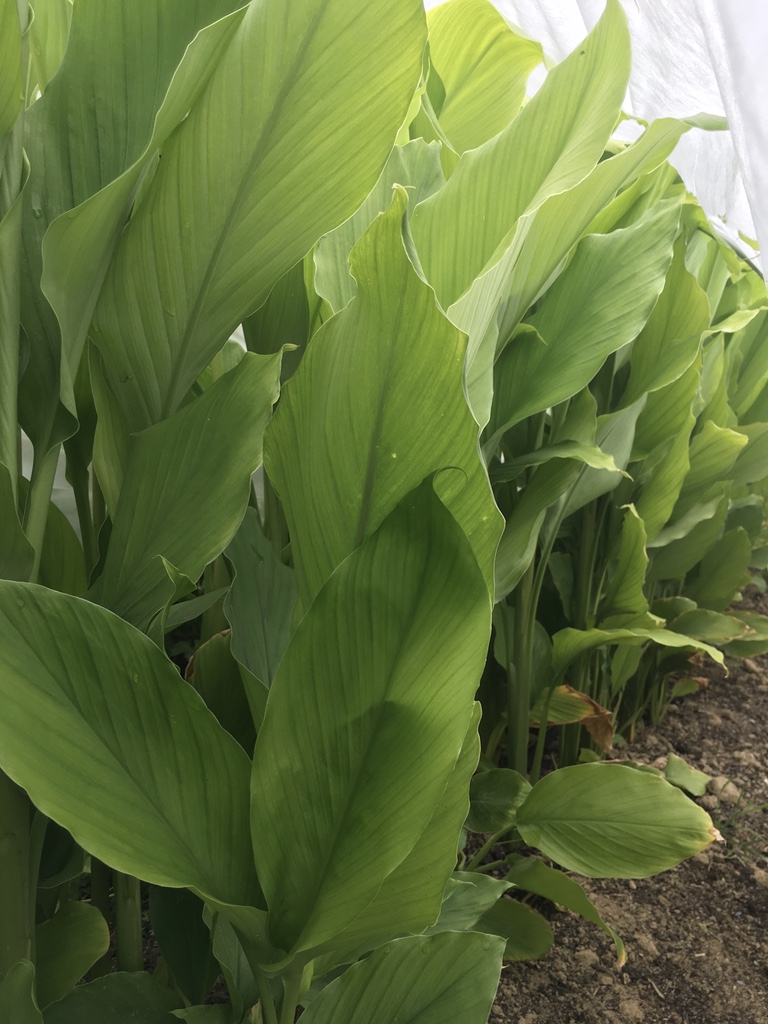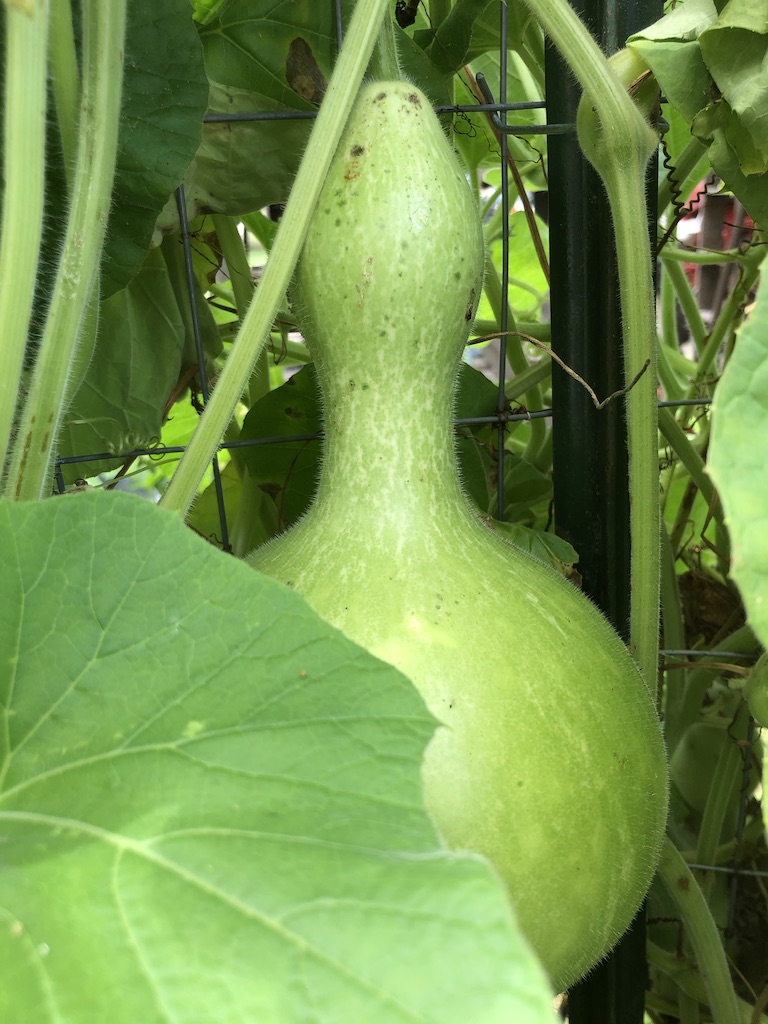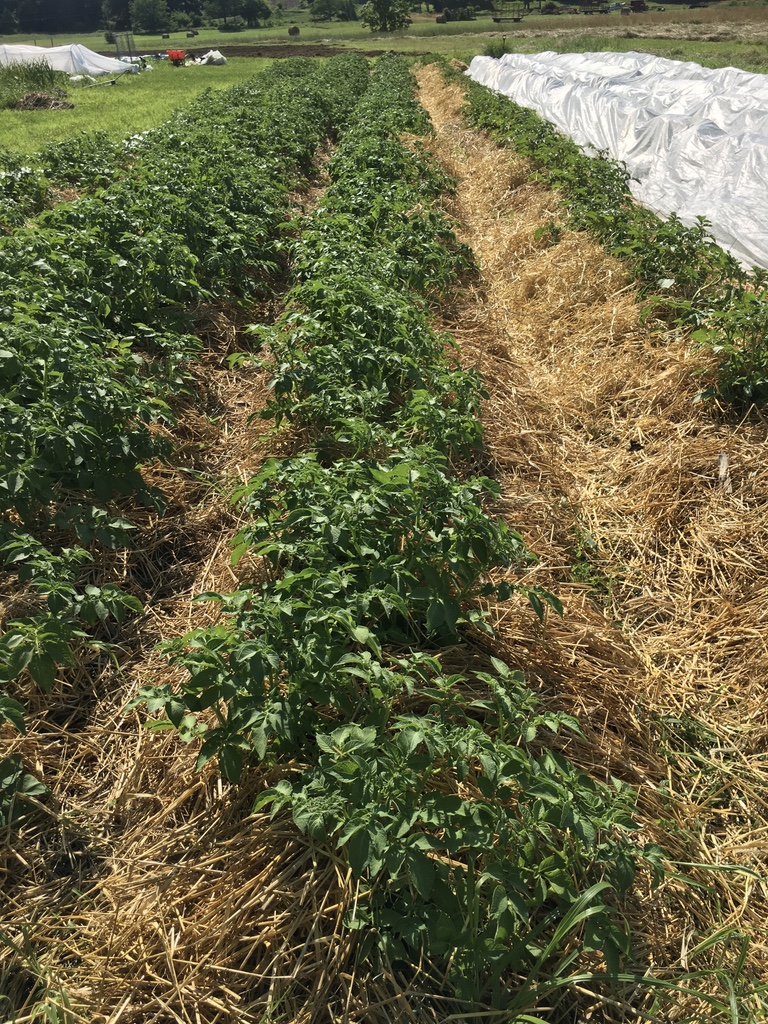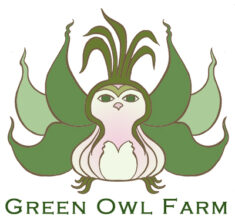GARLIC

We grow three to five varieties of hardneck garlic each year. Hardneck garlic has a center stalk, or long flowering stem, called a scape. We harvest the scapes over a two-week period in early to mid June. They’re delicious! If the scape is not harvested, the flower will develop. The flower is made up of small bulbils and these bulbils can be sown and then replanted over several years to grow garlic bulbs. It’s a long process, but this is one way garlic reproduces.
For most varieties, if the scapes are not removed the garlic bulbs will not grow to maximum size as all the energy will be directed toward the flowers. For this reason, and because we love to eat and market our scapes, we do not plant our garlic from bulbils. Instead, we plant with “seed” garlic. This means that a portion of what grow each year is held back for planting in the fall. We save the largest bulbs, crack them open and plant the cloves. In most cases, one clove will grow into one bulb, although there are some varieties that will produce multiple bulbs from one seed. We sow in late October and harvest in early to mid-July. Over the years we’ve cut back on the number of varieties to only grow those that consistently produce the best for us: German White, Chesnok Red, Spanish Roja, and Hungarian Purple. Some years we also try out one or two other varieties purchasing seed from only organically grown farms.
After harvest, the garlic is trimmed, dried and cleaned. It’s usually ready for sale by mid August. Garlic is sold as seed garlic (large), which is 2″ or more and culinary garlic (medium), which is less than 2″. No matter the size, all of our garlic can be grown and, most importantly, eaten!
SAFFRON

Saffron is our most recent crop addition and we are growing more and more every year. Corms are sown deep in the ground in early September and the crocus flowers emerge in mid-October. There are few sights, here, more inspiring than the field awash in purple flowers just when the season seems to be coming to an end. Harvest takes place over a three week period. After the flowers are harvested, we take them indoors and careful hand-pluck the delicate stigmas from each bloom. Afterwards, we dry the saffron in a dehydrator, bottle and store it in a cool, dark, dry place for at least six months.
Post-harvest, the saffron plants begin to grow long locks of green leaves. This growth continues throughout the winter and into the late spring, even with frigid temperatures and snowfall. At the same time, the corms are multiplying underground, generating new daughters that will increase the harvest the following year. The leaves begin to die back by mid-May and the beds become barren throughout the rest of the summer until the cycle begins all over again.
TURMERIC & GINGER

We grow one type of ginger, Peruvian Yellow, which is well suited to young ginger production, and two types of turmeric, Indira Yellow, which carries a bold flavor and bright yellow interior and Hawaiian Red, which is sweet tasting and vividly orange. Our turmeric and ginger seed, otherwise known as rhizomes, are sourced from a certified organic grower in Hawaii and sprouted indoors in early March. Three months later we transplant the young sprouts outdoors and under tunnels. Over the next few months the beds burst into a lush, tropical oasis. We harvest our turmeric and ginger immature, as “babies,” before they develop a thick rind. Young turmeric and ginger will keep in the refrigerator in air-tight containers for up to two weeks. They can also be frozen for up to a year.
LUFFA

Yes, luffa sponges are grown on the land and not in the ocean. They’re gourds! We start our luffa seeds indoors in mid-March and transplant them into outdoor beds in early June. The vines grow wild on trellises for the next several months, sending out large yellow blooms by early July. Luffa fruits start to form a few weeks later. When the luffas are small and young, they can actually be eaten like a zucchini. But we keep all of our luffas on the vine to grow as long and thick as possible and for their inner core to turn fibrous. From mid-October through early November we harvest the luffas, process them by peeling back their skins, soaking them in water and squeezing out the seeds. Luffas are then air dried, left whole or cut into smaller sized sponges.
BOTTLE GOURDS

We start our bottle gourd seeds indoors in mid-March and transplant them outdoors in early June. The vines grow wild along trellises for the next several months, producing saucer sized white blooms by early July. Bottle gourds start to form a few weeks later. Once the gourds have reached full maturity, we leave them to dry on the vine through the hard frost and the dead of winter. The following spring, all of the gourds are soaked in soap and water and scrubbed clean. A good portion of them are then turned into birdhouses.
Fashioning gourds into nesting sites for birds is an ancient craft and while we treasure taking part in this art, we love just how much the birds seem drawn to them. While our other wooden-framed birdhouses are sometimes left empty, our gourd birdhouses are never vacant. Just as we grow pollinator crops like zinnias and buckwheat each year to create micro-areas for necessary pollinators in a time of great habitat loss, natural nesting sites for birds are dwindling. Supplying these sites feel more important than ever.
We cut our nesting cavity holes to 1.5″ diameter to attract a variety of birds including: bluebird, chickadee, titmouse, nuthatch, wren, swallow and small woodpecker.
FINGERLING POTATOES

Fingerlings are one of the longest-season potato varieties, and that’s likely why we were drawn to them from the start. We grow a tricolored mixture for flavor complexity and also because we just love the way the purples, reds and whites look together. Potato “seeds” are sown in mid-May, hilled with seed-free, clean straw, and protected from potato bugs with fabric cover through the end of June. We begin harvesting in mid-September.
